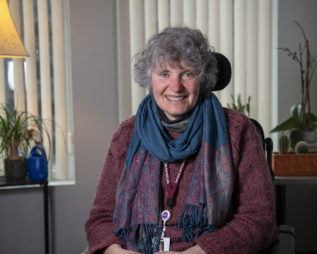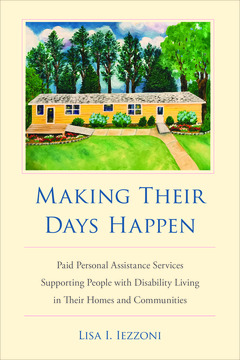Author Interview: Making Their Days Happen by Dr. Lisa Iezzoni

Publication Date: February 28, 2022
 Coalition working group member Dr. Lisa Iezzoni has a new book out called, “Making Their Days Happen.” Today, about 17 million Americans who live in their homes need assistance with daily activities because of disability. Lisa’s book is a deeply thoughtful elevation of voices often missing from our health care and policy discussions – the voices of paid personal assistance services workers and the consumers they support.
Coalition working group member Dr. Lisa Iezzoni has a new book out called, “Making Their Days Happen.” Today, about 17 million Americans who live in their homes need assistance with daily activities because of disability. Lisa’s book is a deeply thoughtful elevation of voices often missing from our health care and policy discussions – the voices of paid personal assistance services workers and the consumers they support.
Here’s our interview with Lisa!
Q: Most Americans want to live in their homes and communities, but many people who need help with their daily activities find themselves living in nursing homes or other facilities. What makes it hard for people to stay in their homes and how has this changed over the years?
 A: For many people with significant disability, staying in their own homes and communities is essential to their dignity – remaining in their familiar private spaces, following their own routines, with family and friends nearby. This preference seems self-evident for most people, especially when juxtaposed with the alternative of being institutionalized. Among European settlers in colonial times, families were expected to care in-home for their relatives with chronic disease or disability; much harsher realities confronted disabled indigenous people displaced from their lands, enslaved people with disability, and poor people without homes. The first almshouse for homeless people with disease or disability opened in Boston in 1662 and hundreds of others followed across America. Centuries later, the two major barriers keeping people with disability from staying in their homes remain similar – lacking families who can provide daily in-home care or the money to afford paid personal assistance services.
A: For many people with significant disability, staying in their own homes and communities is essential to their dignity – remaining in their familiar private spaces, following their own routines, with family and friends nearby. This preference seems self-evident for most people, especially when juxtaposed with the alternative of being institutionalized. Among European settlers in colonial times, families were expected to care in-home for their relatives with chronic disease or disability; much harsher realities confronted disabled indigenous people displaced from their lands, enslaved people with disability, and poor people without homes. The first almshouse for homeless people with disease or disability opened in Boston in 1662 and hundreds of others followed across America. Centuries later, the two major barriers keeping people with disability from staying in their homes remain similar – lacking families who can provide daily in-home care or the money to afford paid personal assistance services.
Q: Over three-quarters of Americans who need in-home support for activities of daily living receive this assistance from unpaid family members or friends, so-called “informal caregivers.” In contrast, paid personal assistance services (PAS) workers are a key resource for individuals with complex needs and/or limited social networks. Who are these “formal” caregivers? Why did you want to write a book about them?
A: The terminology for paid PAS workers is evolving and differs across regions and contexts; examples include “personal care assistants” and “home health aides.” In essence PAS workers provide critical support to people with significant disability who do not have adequate informal assistance to live in their homes and communities. Most PAS workers are women of color who earn low wages; many are immigrants. Much has been written about the impending gap between the need for home-based supportive services and the workforce available to meet this need. Over the last two decades, blue ribbon commissions of experts have convened to discuss this and other imminent crises of long-term services and supports in America. Yet something has been missing from their copious reports and pronouncements: the voices of PAS consumers with significant disability and of PAS workers. Also missing are detailed descriptions of exactly how consumers and PAS workers approach and view their intimate interactions in consumers’ bedrooms, bathrooms, kitchens, and behind closed doors, and what dignity looks like day-to-day to consumers and to workers. Bringing these missing voices into the light was why I wanted to write this book.
Q: You interviewed more than 40 people for this book, including both PAS consumers and workers. What do you hope readers come away with after immersing themselves in their lives?
A: The book uses stories I heard from PAS consumers and workers to make the basic point that all policies are personal – health care policies, labor policies, housing and transportation policies. These policies affect real people in significant ways. I dedicated the book to my friend Michael, who is completely paralyzed below his neck from primary progressive multiple sclerosis, and his longest-serving PAS worker, Nelita. From watching them across more than a decade, I learned so much. Nelita, who had immigrated from Haiti many years ago, always had two or three jobs to make ends meet. She worked more than 12 hours per day six days each week, her only respite on the sabbath. Across the years, she had minimal or no health insurance or other employment benefits. Despite this, she and her husband put their son through nursing school, and he is now headed to graduate school.
I looked the other day, and in 2020 the hourly wage for PAS workers was $13.02 according to the Bureau of Labor Statistics. Annual earnings were about $27,000. I want to underscore a central irony about PAS, which winds throughout the book. On the one hand, PAS is low-wage, physically demanding work, currently with few opportunities for career growth. The work is often stigmatized by its association with gender roles and the intimate tasks performed, supporting the most basic functions of the human body. On the other hand, people like my friend Michael literally could not live without his paid PAS workers. They not only support his daily activities but also they have identified health problems that could have dramatically worsened without immediate clinical attention. Thus, the discordance between how disabled people view PAS and the worth ascribed by society, as measured in wages, public recognition, and prestige, is vast.
